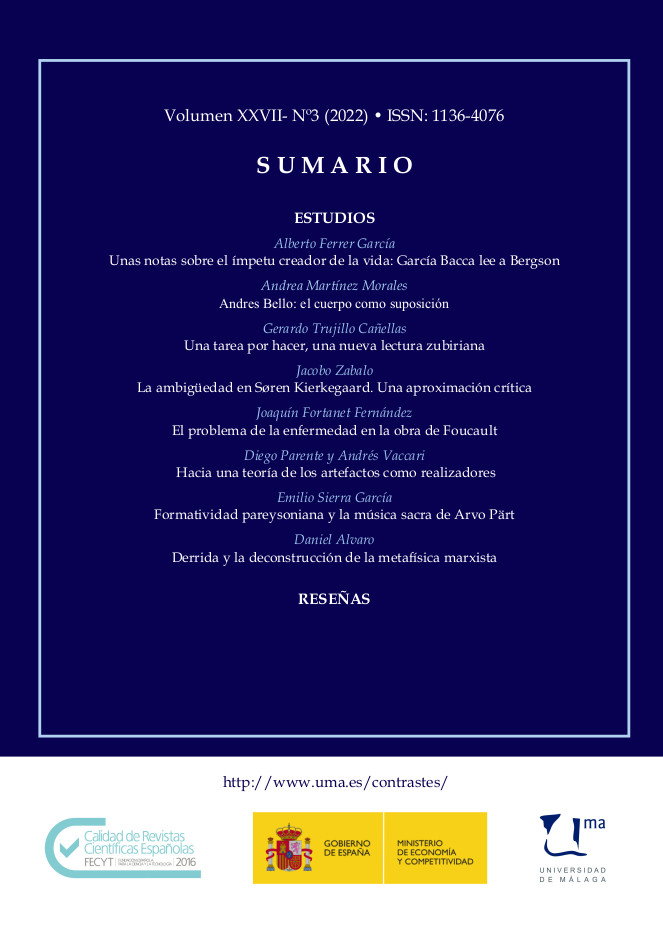Pareysonian formativity and musical minimalism
DOI:
https://doi.org/10.24310/Contrastescontrastes.v27i3.13982Keywords:
Formativity, Pareyson, Arvo Pärt, Trascendence, Spirituality of artAbstract
This article summarizes the foundations of the aesthetic theory formulated by Luigi Pareyson. Matter and form constitute the work and in them there is a union between the spiritual and the material showing the essence of the beautiful-true in transcendence. The perception of the senses and the matter-spirit interaction will lead us to the sources of aesthetic experience as an experience of being. Arvo Pärt will manifest this in Berliner Messe and Cantus in memoriam of Benjamin Britten. Form opens matter to spirit and spirit opens art to transcendence.
Downloads
Metrics
Publication Facts
Reviewer profiles N/A
Author statements
Indexed in
-
—
- Academic society
- N/A
- Publisher
- Universidad de Málaga
References
ADELL, A. 2011: El arte como expiación. Madrid: Casimiro.
AZNAR ALMAZÁN, S. 2006: El arte de acción. Madrid: Nerea.
AZNAR ALMAZÁN, S. y MARTÍNEZ PINO, J. 2009: Últimas tendencias del arte. Madrid: Editorial universitaria Ramón Areces.
CONILL SANCHO, J. 1997: El poder de la mentira. Nietzsche y la política de la transvaloración. Madrid: Tecnos.
CONILL SANCHO, J. 2019: Intimidad corporal y persona humana. De Nietzsche a Ortega y Zubiri. Madrid: Tecnos.
CRUZ SÁNCHEZ, P. A. 2013: Cuerpo, ingravidez y enfermedad. Barcelona: Bellaterra.
DEL VALLE CORDERO, A. (2013), «Ana Mendieta: Performance a la manera de los primitivos», Arte, Individuo y Sociedad, 26 (1) pp. 67-82.
DELEUZE, G. 2002: Nietzsche y la filosofía. Barcelona: Anagrama.
FOUCAULT, M. 2019: Historia de la Sexualidad IV. Las confesiones de la carne. Madrid : Akal.
GUASCH, A. M. 2007: El arte último del siglo XX. Del postminimalismo a lo multicultural. Madrid: Alianza.
JARA, J. (2009), «Hermenéutica genealógica desde el cuerpo», Estudios Nietzsche. Nietzsche y la hermenéutica, IX, pp. 15-23.
JARA, J. 1998: Nietzsche, un pensador póstumo. El cuerpo como centro de gravedad. Barcelona: Anthropos.
NIETZSCHE, F. 2010-2016: Obras completas. Madrid: Tecnos.
NIETZSCHE, F. 2006-2010: Fragmentos póstumos. Madrid: Tecnos.
ONFRAY M. 2011: La Construction du surhomme. Paris: Graset.
ONFRAY, M. 2011: Freud. El crepúsculo de un ídolo. Madrid: Taurus.
OTERO LEÓN, L. (2008), «De la estética como fisiología en Nietzsche a la curación como obra de arte en Gadamer», Contrastes, Revista Internacional de Filosofía, XIII, pp. 19-35,
RUDINESCO, E. 2011: ¿Por qué tanto odio? Buenos Aires: Libros del Zorzal.
SALGADO, E. 2007: Cumbre y abismo en la filosofía de Nietzsche. El cultivo de sí mismo, Madrid, Plaza y Valdés.
SÁNCHEZ MECA, D. (2001), «Nietzsche o el sueño de la gran salud», Paideía, 58, pp. 505-522.
SÁNCHEZ MECA, D. (2002), «Psicofisiología nietzscheana del arte y de la decadencia», en J. Rivera de Rosales y Ma. C. López Sáez (Coords.), El cuerpo. Perspectivas filosóficas. Madrid: UNED, pp. 107-132.
SÁNCHEZ MECA, D. (2009), «Voluntad de poder e interpretación como supuestos de todo proceso orgánico», Estudios Nietzsche, 9, pp. 105-122.
SÁNCHEZ MECA, D. 1989: En torno al superhombre. Nietzsche y la crisis de la modernidad. Barcelona: Anthropos.
SÁNCHEZ MECA, D. 2005: Nietzsche. La experiencia dionisiaca del mundo, Madrid, Tecnos.
SANTIAGO GUERVÓS, L. E. 2004: Arte y poder. Aproximación a la estética de Nietzsche. Madrid: Trotta.
SEDEÑO VALDELLÓS, A. (2010), «Cuerpo, dolor y rito en la performance: Las prácticas artísticas de Ron Athey», Nómadas. Revista Crítica de Ciencias Sociales y Jurídicas, 27.
SEGALEN, M. 2005: Ritos y rituales contemporáneos. Madrid: Alianza.
SOLÁNS, P. 2007: Accionismo vienés. Madrid: Nerea.
VALLE-CORDERO, A. (2014), « Ana Mendieta: Performance a la manera de los primitivos » Arte, individuo y sociedad, 26 (1) pp. 67-82.
Downloads
Published
How to Cite
Issue
Section
License
This journal provides immediate free access to its content under the principle of making research freely available to the public. All content published in Contrastes. Revista Internacional de Filosofía, are subject to the Creative Commons Attribution-NonCommercial-ShareAlike 4.0 license whose full text can be found at <http://creativecommons.org/licenses/by-nc-sa/4.0>
It is the responsibility of the authors to obtain the necessary permissions of the images that are subject to copyright.
Authors whose contributions are accepted for publication in this journal will retain the non-exclusive right to use their contributions for academic, research and educational purposes, including self-archiving or repository in open access repositories of any kind.
The electronic edition of this magazine is edited by the Editorial Service of the University of Malaga (Uma Editorial), being necessary to cite the origin in any partial or total reproduction.










5.png)
